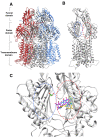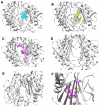Sodium Malonate Inhibits the AcrAB-TolC Multidrug Efflux Pump of Escherichia coli and Increases Antibiotic Efficacy
- PMID: 36558743
- PMCID: PMC9781404
- DOI: 10.3390/pathogens11121409
Sodium Malonate Inhibits the AcrAB-TolC Multidrug Efflux Pump of Escherichia coli and Increases Antibiotic Efficacy
Abstract
There is an urgent need to find novel treatments for combating multidrug-resistant bacteria. Multidrug efflux pumps that expel antibiotics out of cells are major contributors to this problem. Therefore, using efflux pump inhibitors (EPIs) is a promising strategy to increase antibiotic efficacy. However, there are no EPIs currently approved for clinical use especially because of their toxicity. This study investigates sodium malonate, a natural, non-hazardous, small molecule, for its use as a novel EPI of AcrAB-TolC, the main multidrug efflux pump of the Enterobacteriaceae family. Using ethidium bromide accumulation experiments, we found that 25 mM sodium malonate inhibited efflux by the AcrAB-TolC and other MDR pumps of Escherichia coli to a similar degree than 50 μΜ phenylalanine-arginine-β-naphthylamide, a well-known EPI. Using minimum inhibitory concentration assays and molecular docking to study AcrB-ligand interactions, we found that sodium malonate increased the efficacy of ethidium bromide and the antibiotics minocycline, chloramphenicol, and ciprofloxacin, possibly via binding to multiple AcrB locations, including the AcrB proximal binding pocket. In conclusion, sodium malonate is a newly discovered EPI that increases antibiotic efficacy. Our findings support the development of malonic acid/sodium malonate and its derivatives as promising EPIs for augmenting antibiotic efficacy when treating multidrug-resistant bacterial infections.
Keywords: AcrAB-TolC; EPI; Escherichia coli; efflux pump inhibitor; malonate; malonic acid; multidrug efflux pump; sodium malonate.
Conflict of interest statement
The authors declare no conflict of interest. The funders had no role in the design of the study; in the collection, analyses, or interpretation of data; in the writing of the manuscript, or in the decision to publish the results.
Figures





Similar articles
-
Drug Efflux Pump Inhibitors: A Promising Approach to Counter Multidrug Resistance in Gram-Negative Pathogens by Targeting AcrB Protein from AcrAB-TolC Multidrug Efflux Pump from Escherichia coli.Biology (Basel). 2022 Sep 8;11(9):1328. doi: 10.3390/biology11091328. Biology (Basel). 2022. PMID: 36138807 Free PMC article. Review.
-
The Multidrug Efflux Regulator AcrR of Escherichia coli Responds to Exogenous and Endogenous Ligands To Regulate Efflux and Detoxification.mSphere. 2022 Dec 21;7(6):e0047422. doi: 10.1128/msphere.00474-22. Epub 2022 Nov 23. mSphere. 2022. PMID: 36416552 Free PMC article.
-
Identification of AcrAB-TolC Efflux Pump Genes and Detection of Mutation in Efflux Repressor AcrR from Omeprazole Responsive Multidrug-Resistant Escherichia coli Isolates Causing Urinary Tract Infections.Microbiol Insights. 2019 Dec 4;12:1178636119889629. doi: 10.1177/1178636119889629. eCollection 2019. Microbiol Insights. 2019. PMID: 31839709 Free PMC article.
-
Mapping the Role of AcrAB-TolC Efflux Pumps in the Evolution of Antibiotic Resistance Reveals Near-MIC Treatments Facilitate Resistance Acquisition.mSphere. 2020 Dec 16;5(6):e01056-20. doi: 10.1128/mSphere.01056-20. mSphere. 2020. PMID: 33328350 Free PMC article.
-
Efflux pump inhibitors of clinically relevant multidrug resistant bacteria.Med Res Rev. 2019 Nov;39(6):2460-2504. doi: 10.1002/med.21591. Epub 2019 Apr 19. Med Res Rev. 2019. PMID: 31004360 Review.
Cited by
-
A growing battlefield in the war against biofilm-induced antimicrobial resistance: insights from reviews on antibiotic resistance.Front Cell Infect Microbiol. 2023 Dec 19;13:1327069. doi: 10.3389/fcimb.2023.1327069. eCollection 2023. Front Cell Infect Microbiol. 2023. PMID: 38188636 Free PMC article. Review.
-
Assessment of Antimicrobial Activity of Chitosan, ZnO, and Urtica dioica-ZnO NPs Against Staphylococcus aureus Isolated from Diabetic Ulcers.Curr Microbiol. 2024 Aug 3;81(9):295. doi: 10.1007/s00284-024-03633-9. Curr Microbiol. 2024. PMID: 39096343
-
Small molecular adjuvants repurpose antibiotics towards Gram-negative bacterial infections and multispecies bacterial biofilms.Chem Sci. 2023 Nov 15;15(1):259-270. doi: 10.1039/d3sc05124b. eCollection 2023 Dec 20. Chem Sci. 2023. PMID: 38143555 Free PMC article.
-
TolCV1 inhibition by NPPB renders Vibrio vulnificus less virulent and more susceptible to antibiotics.Antimicrob Agents Chemother. 2025 Jan 31;69(1):e0050224. doi: 10.1128/aac.00502-24. Epub 2024 Dec 13. Antimicrob Agents Chemother. 2025. PMID: 39670721 Free PMC article.
-
Physiological Effects of TolC-Dependent Multidrug Efflux Pumps in Escherichia coli: Impact on Motility and Growth Under Stress Conditions.Microbiologyopen. 2024 Dec;13(6):e70006. doi: 10.1002/mbo3.70006. Microbiologyopen. 2024. PMID: 39529380 Free PMC article.
References
-
- O’Neill J. Antimicrobial Resistance: Tackling a Crisis for the Health and Wealth of Nations. The Review on Antimicrobial Resistance 2014. [(accessed on 1 July 2022)]. Available online: https://amr-review.org/sites/default/files/AMR%20Review%20Paper%20-%20Ta....
-
- Centers for Disease Control and Prevention . Antibiotic Resistance Threats in the United States, 2019. Centers for Disease Control and Prevention; Atlanta, GA, USA: 2019.
Grants and funding
LinkOut - more resources
Full Text Sources

